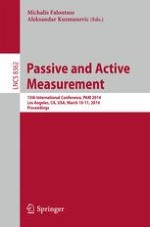This book constitutes the refereed proceedings of the 15th International Conference on Passive and Active Measurement, PAM 2014, held in Los Angeles, CA, USA, in 2014. The 24 revised full papers presented were carefully reviewed and selected from 76 submissions. The papers have been organized in the following topical sections: internet wireless and mobility; measurement design, experience and analysis; performance measurement; protocol and application behavior; characterization of network behavior; and network security and privacy. In addition 7 poster papers have been included.
